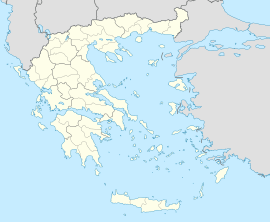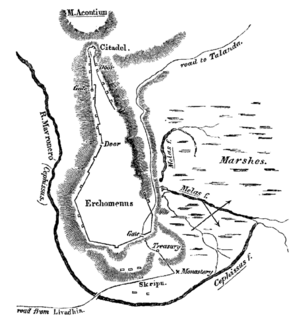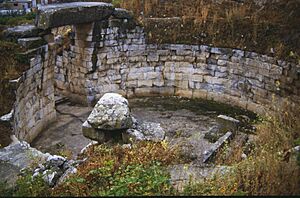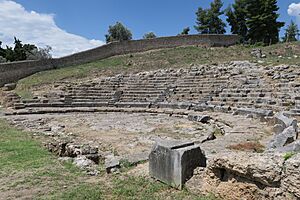Orchomenus (Boeotia) facts for kids
Quick facts for kids
Orchomenos
Ορχομενός
|
|
|---|---|
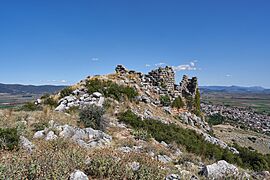
The Acropolis of Orchomenus
|
|
| Country | Greece |
| Administrative region | Central Greece |
| Regional unit | Boeotia |
| Area | |
| • Municipality | 415.9 km2 (160.6 sq mi) |
| • Municipal unit | 230.098 km2 (88.841 sq mi) |
| Population
(2021)
|
|
| • Municipality | 9,381 |
| • Municipality density | 22.556/km2 (58.420/sq mi) |
| • Municipal unit | 7,105 |
| • Municipal unit density | 30.8781/km2 (79.974/sq mi) |
| Community | |
| • Population | 4,285 (2021) |
| • Area (km2) | 43.431 |
| Time zone | UTC+2 (EET) |
| • Summer (DST) | UTC+3 (EEST) |
Orchomenus (Ancient Greek: Ὀρχομενός Orchomenos) is a very old place in Boeotia, Greece. It is famous for its many early Greek myths. Today, it is known as a rich archaeological site. People lived here from the Neolithic (New Stone Age) through the Hellenistic periods. Sometimes it's called "Minyan Orchomenus" to tell it apart from another city with the same name in Arcadia.
Contents
Orchomenus has a long and exciting history. It was home to powerful people and saw many important battles.
The Minyans and Early History
The founding story of Orchomenus says that its first royal family came from the Minyans. They followed their leader, Minyas, from Thessaly to settle this area.
During the Bronze Age, around 1400 to 1200 BC, Orchomenus became a very rich and important place. It was a major center of civilization in Mycenaean Greece. It even competed with the powerful city of Thebes.
The city had a grand palace with painted walls. There was also a huge beehive tomb, which showed how powerful Orchomenus was. People living here also did a massive project to drain the marshes of Lake Kopaïs. This turned the area into rich farmland. Like many places around the Aegean Sea, Orchomenus was burned and its palace destroyed around 1200 BC. This happened during a time called the Bronze Age Collapse.
Orchomenus is even mentioned in Homer's famous poem, the Iliad. It says that Orchomenus, along with Aspledon, sent thirty ships to fight in the Trojan War.
Orchomenus was one of the city-states that joined the Calaurian maritime League in the 7th century BC. This was a group of cities that worked together. Later, around 600 BC, Orchomenus joined the Boeotian League, which was led by its rival, Thebes.
Festivals and Coinage
Classical Orchomenus was famous for its special place dedicated to the Charites or Graces. These were goddesses of charm and beauty. They had their earliest worship here. Musical and poetry contests, called the Charitesia, were held in their honor. The city also had a festival for the god Dionysus called the Agrionia. Orchomenus started making its own coins in the mid-6th century BC.
Wars and Rebuilding
In 480–479 BC, the people of Orchomenus joined Thebes to fight against the invading forces of Xerxes in the Greco-Persian Wars. Later, in the 4th century BC, Orchomenus sided with Sparta against Thebes. This was because of their old rivalry.
After Thebes defeated Sparta in the Battle of Leuctra (371 BC), the Boeotian League attacked Orchomenus in 364 BC. The city was rebuilt by the Phocians in 355 BC, but Thebes destroyed it again in 349 BC.
The flat land between Orchomenus and the acropolis of Chaeronea saw two very important battles.
- First Battle of Chaeronea (338 BC): In 338 BC, Philip II of Macedon defeated Thebes and Athens here. This battle made Macedon the most powerful force over the Greek city-states. Philip's young son, Alexander the Great, also showed his skills here.
- Second Battle of Chaeronea (86 BC): This battle happened when Roman Republican forces, led by Sulla, defeated King Mithridates VI of Pontus. After this, the Battle of Orchomenus took place, where Mithridates' forces were completely destroyed.
Orchomenus remained a small town for a long time after these events.
Archaeologists have learned a lot about Orchomenus by digging up its ancient remains.
What Archaeologists Found
- Early Bronze Age Homes: Round houses, about two to six meters wide, from the Early Bronze Age (2800–1900 BC) have been found.
- The Tomb of Minyas: In the 1880s, Heinrich Schliemann found a large beehive tomb he called the "Tomb of Minyas". It was a huge Mycenaean monument, as grand as the "Tomb of Atreus" in Mycenae. This tomb was likely built for the royal family around 1250 BC. It was visible for many centuries and even became a place of worship later on. The entrance has a massive stone lintel that is six meters long. The inside was decorated with bronze flowers and spirals.
- Mycenaean Palace: A Mycenaean palace was found east of the Tomb of Minyas. It had three parts, and some were decorated with beautiful paintings. The palace was destroyed around 1200 BC.
- Fortification Walls: The strong walls around Orchomenus were built in the late 4th century BC by the Macedonians. You can still see them today on Mount Akontion.
- The Ancient Theatre: A theatre was built around the end of the 4th century BC. The seating area for spectators, the stage, and part of the orchestra are still there. It was used until late Roman times, around 400 AD.
Important Excavations
Many people have helped uncover Orchomenus's past:
- Heinrich Schliemann: His work in 1880–86 revealed the famous "Tomb of Minyas."
- A. de Ridder: In 1893, he dug up the temple of Asklepios and some Roman burials.
- Bavarian Archaeological Mission: From 1903–05, a team led by Heinrich Bulle and Adolf Furtwängler found more important things.
- Theodore Spyropoulos: In the 1970s, his team found the Mycenaean palace, a prehistoric cemetery, and the theatre.
Orchomenus is also known for its art and a special type of pottery.
Orchomenos Sculpture Style
A style of ancient Greek statues called Kouroi is named after Orchomenus. This "Orchomenos-Thera group" dates from 590–570 BC. Sculptors in this period made ears less flat, eyes more rounded, and mouths more natural. They also started showing more details of the body.
Minyan Ware Pottery
The term "Minyan ware" was created to describe a specific type of pottery first found here. It's a special kind of pottery that helps archaeologists understand the past.
Orchomenus continued to be important even after ancient times.
The Byzantine Church
Across from the ancient theatre is a 9th-century Byzantine church. It's called the Dormition of the Virgin Mary (Panagia) of Skripou. Inscriptions show it was built in 873/4. It was sponsored by Leon, an important official for Emperor Basil I.
The modern municipality of Orchomenos was formed in 2011. It combined two smaller areas: Akraifnia and Orchomenos. The main town of the municipality is also called Orchomenos. The total area of the municipality is about 415.9 square kilometers.
See Also
- Achaean League
- Orchomenos, a king in Greek mythology.
- Erginus, king of Orchomenus.
- Elara and her son Tityos
- Eurybotadas
- Cephissus


